Our veggie patch took on greater significance during the stringent first lockdown level of the pandemic when even grocery shopping could be a fraught experience. At the very last local farmers’ market that took place just before the late-March lockdown commenced, we bought some winter veg seedlings to add to our vegetable garden.
In the subsequent months it has been comforting to have a source of fresh leaves and other items freshly picked from the garden to brighten up a sandwich or a supper. I don’t think of myself as a gardener’s gardener, as over the years we have adapted to our veggie patch more than it has adapted to us. We have learned what grows more reliably in our hot humid conditions in a soil that can tend towards clay, and have more or less limited ourselves to what grows most easily.

Of course nothing is ever truly reliable, and this past winter the usually dependable self-seeded cherry tomato were less abundant than usual, perhaps due to quirks in the weather and inconsistencies on our part tending the veggie garden.

Cherry tomatoes manage to produce at least something in our humid conditions, and a plus is that the small flowers are rather pretty. Whenever we have tried growing standard or plum tomatoes the yield has been very low – or even nothing at all – as such tomato plants are very susceptible to humidity-induced ailments.
We have much better luck with lettuce, which does best in the cooler winter months paradoxically when salad is less appealing, but during the winter months of the lockdowns we really enjoyed access to fresh lettuce. We usually grow Cos-style lettuce so that individual leaves can be harvested when needed while leaving the plant to continue growing.
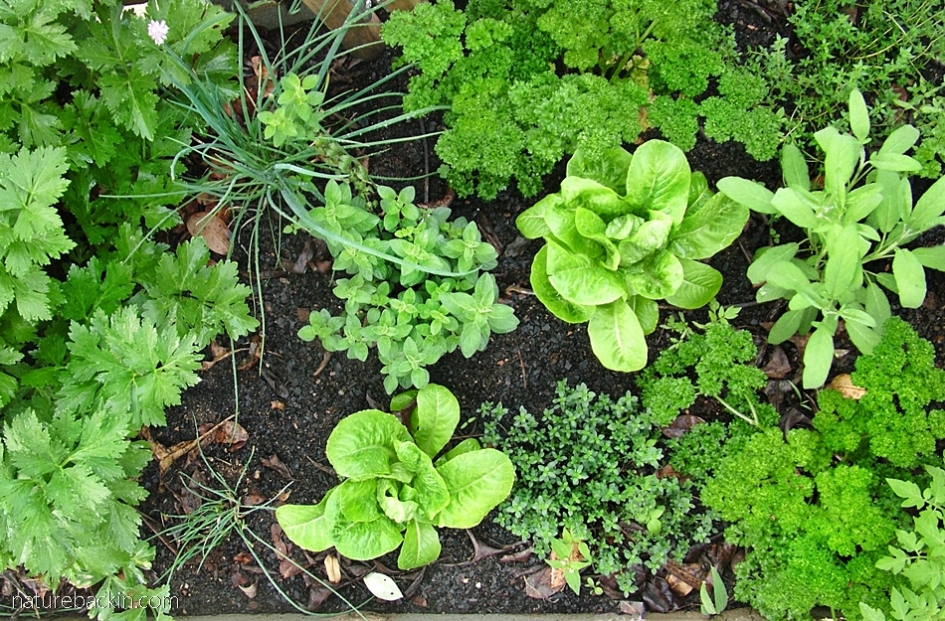
Lettuce and herbs – celery, chives, parsley, Greek organum, thyme and sage – grow in a raised herb bed. Given enough sun most herbs are easy to cultivate, although we have found that sage can be a bit finicky.
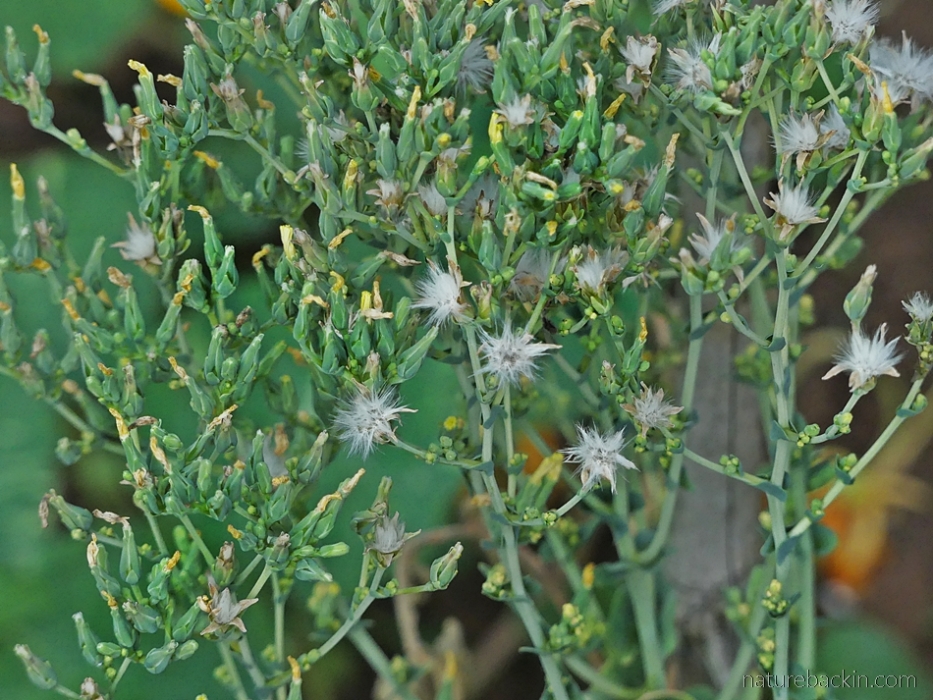
Each Cos-style lettuce has a picking period of several weeks, and then we leave plants to go to seed as in the photo above, as they obligingly self-seed if we leave a patch of bare earth to allow the seedlings to establish themselves.
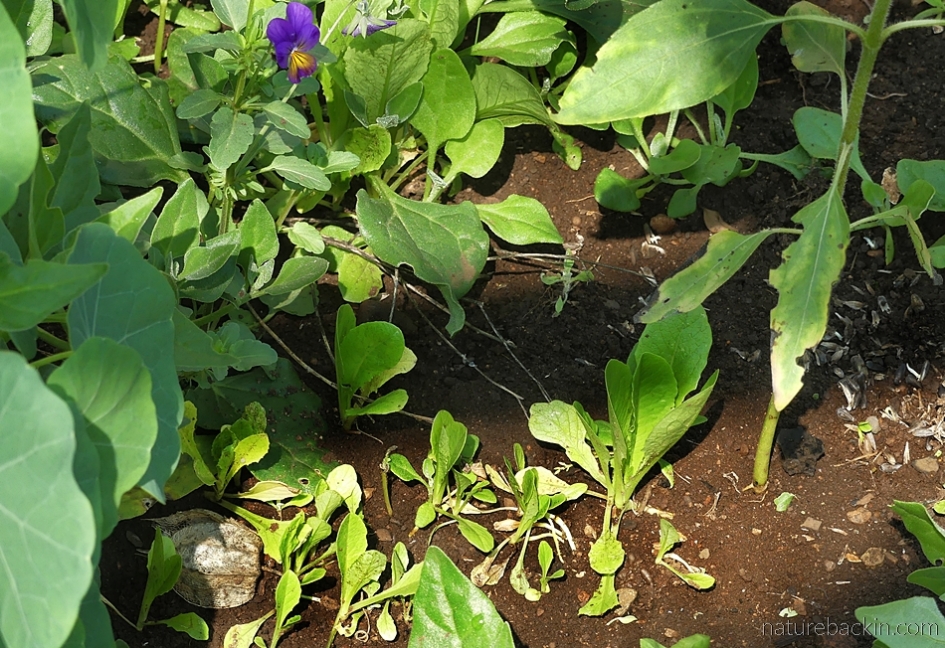
These self-seeded lettuce seedlings are a bit straggly as I was a bit late clearing a patch in amongst the nasturtiums and New Zealand spinach to accommodate them, but as they strengthen I will transplant them so that each plant has more space.
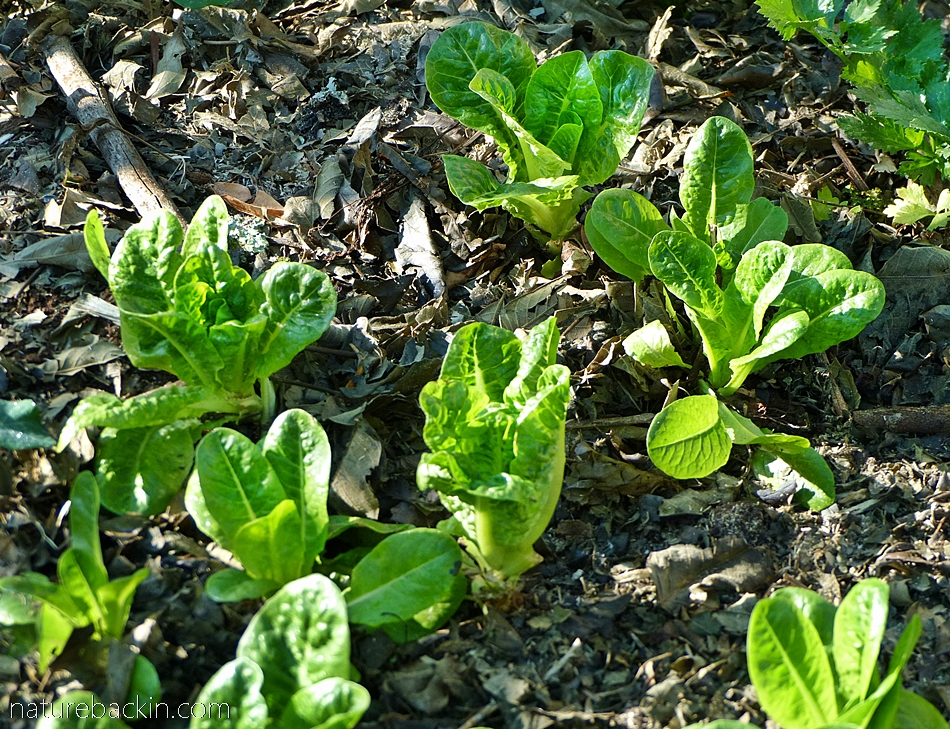
In a previous season these young self-seeded lettuces were planted out and mulched with dry leaves. When we first started growing veggies we would plant low-growing plants, such as pennyroyal and thyme, as living mulch but we found that this method upped our snail population. Once we stopped this practice of growing living mulch the snails almost entirely disappeared. We now try to keep the pennyroyal confined to the pathways and between the paving stones as it makes a robust and mat-like ground cover.
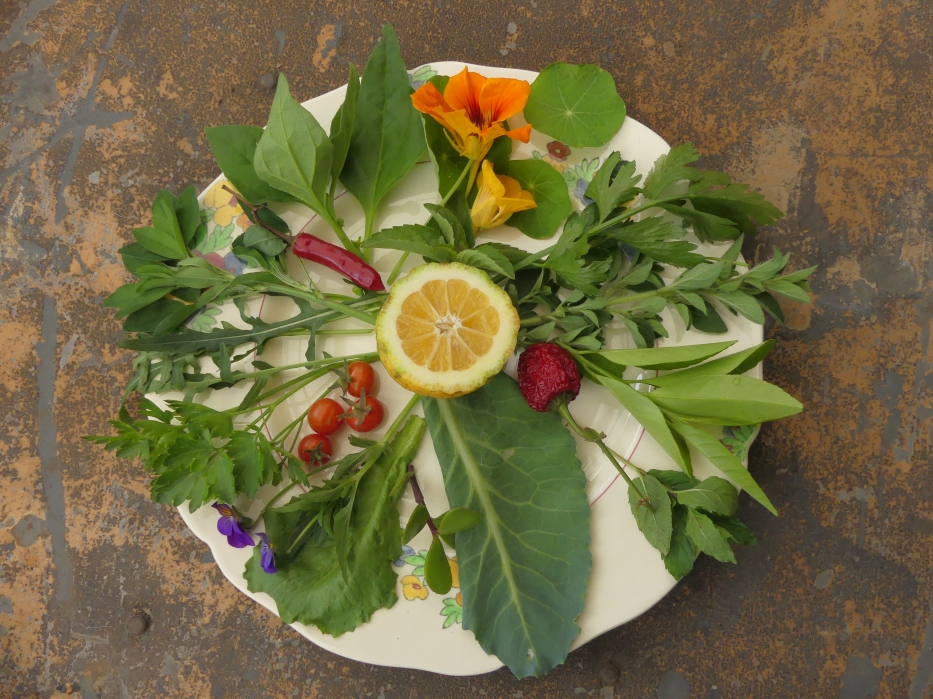
Displayed on a plate are a variety of “lockdown leaves” and other items that I picked today from our veggie garden. During the past winter we used the leaves for pepping up sandwiches and other snacks or for adding to stews. In the above photo, starting with the nasturtium flowers and leaves and moving clockwise we have celery, organum, lime leaves, a dried pepperdew that remained on one of the plants (as they are over now but new fruits are starting to appear), mint, cabbage, spekboom, lettuce, pansies, tomatoes, flat-leaf parsley, rocket, alfalfa (lucerne), chilli, New Zealand spinach and basil. I nearly forgot to mention the slice of home-grown lemon in the centre.

Well into the winter we had a constant supply of small pepperdews. I used to find the taste a bit disappointing, but during the lockdown they came into their own chopped up to be sprinkled on sandwiches and in mini-salads or to fry with onion and garlic as a base for a vegetable soup or stew.
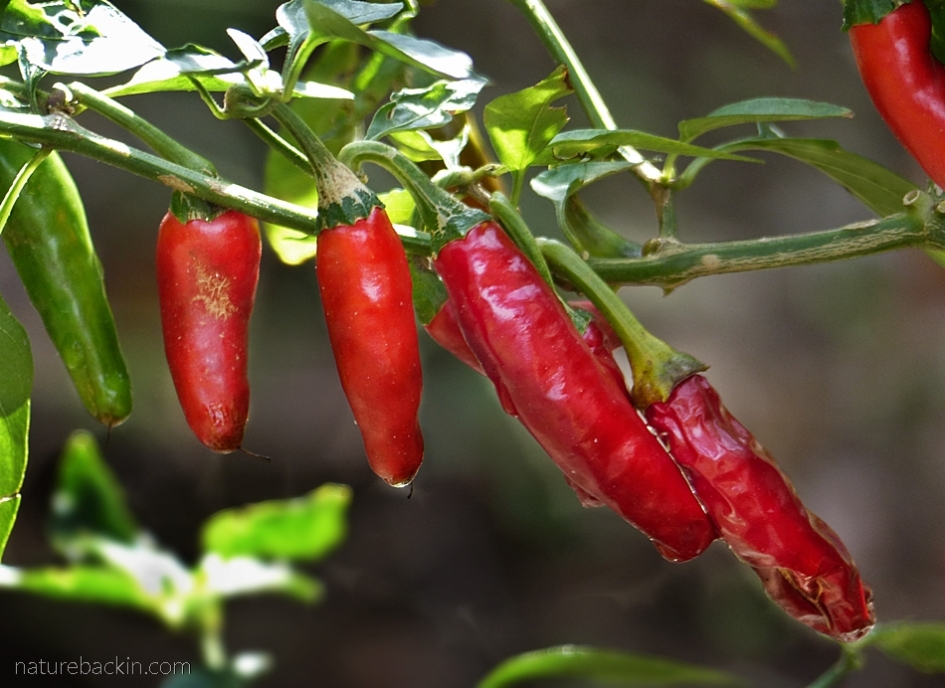
Chillies grow well here and bear prolifically. We store the excess by freezing chillies whole to store in the freezer and I keep meaning to make a chilli pickle in the tradition of my father-in-law who used to pickle chillies in sherry.
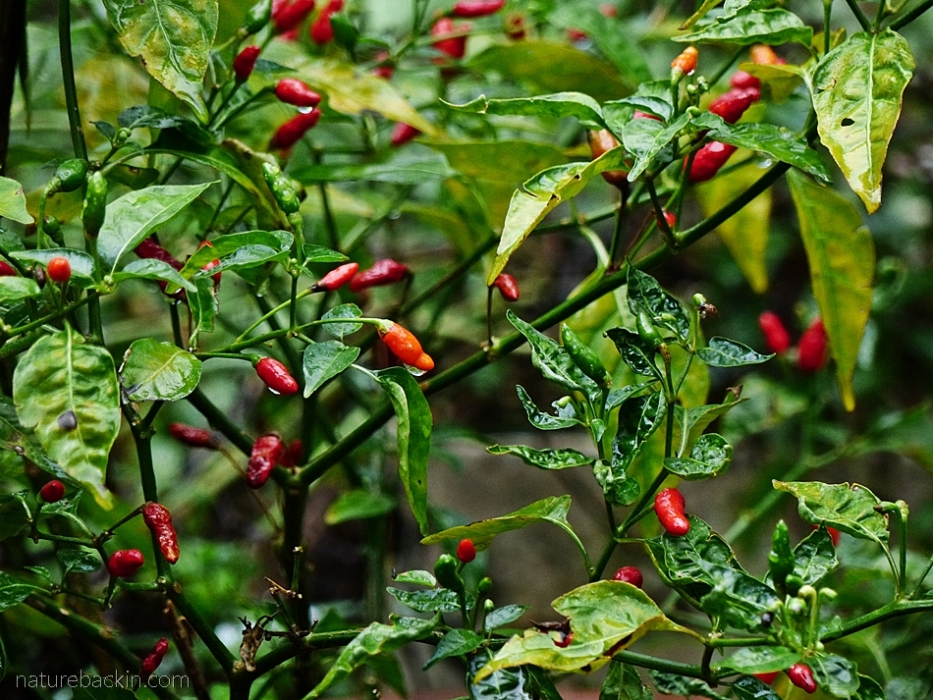
These birds’ eye chillies were good while they lasted. I forgot to store seed and did not replace the plant after it died after one season.
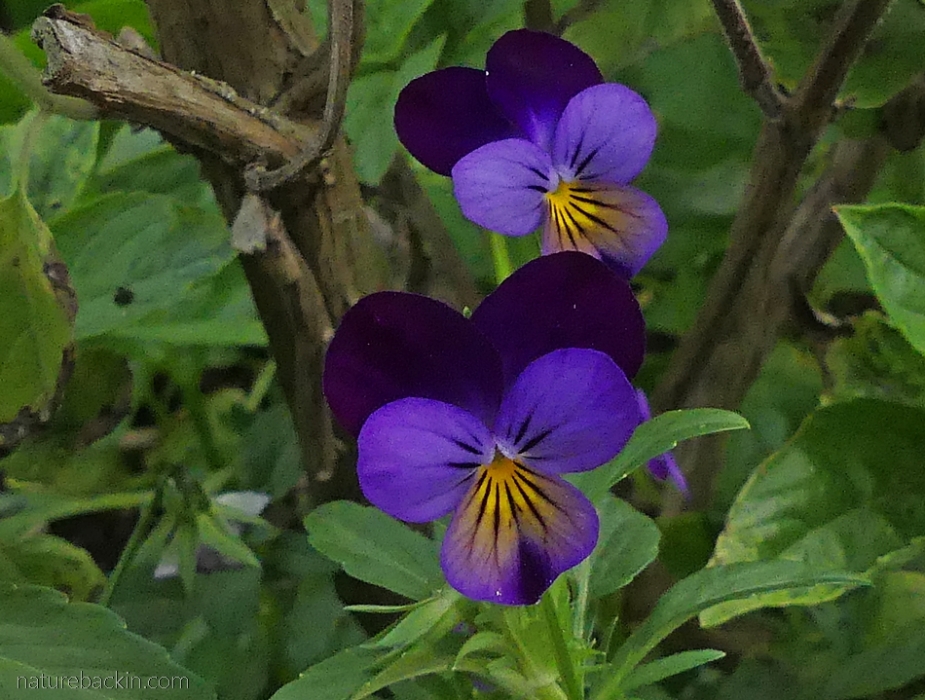
For some reason I started growing pansies in the vegetable garden some years ago. Each year some self-seed but the variety has decreased over time and these lovely little flowers are the tenacious ones that continue to come up each year to brighten up the veggie patch. The flowers are edible yet I find that I prefer to leave them in the garden.
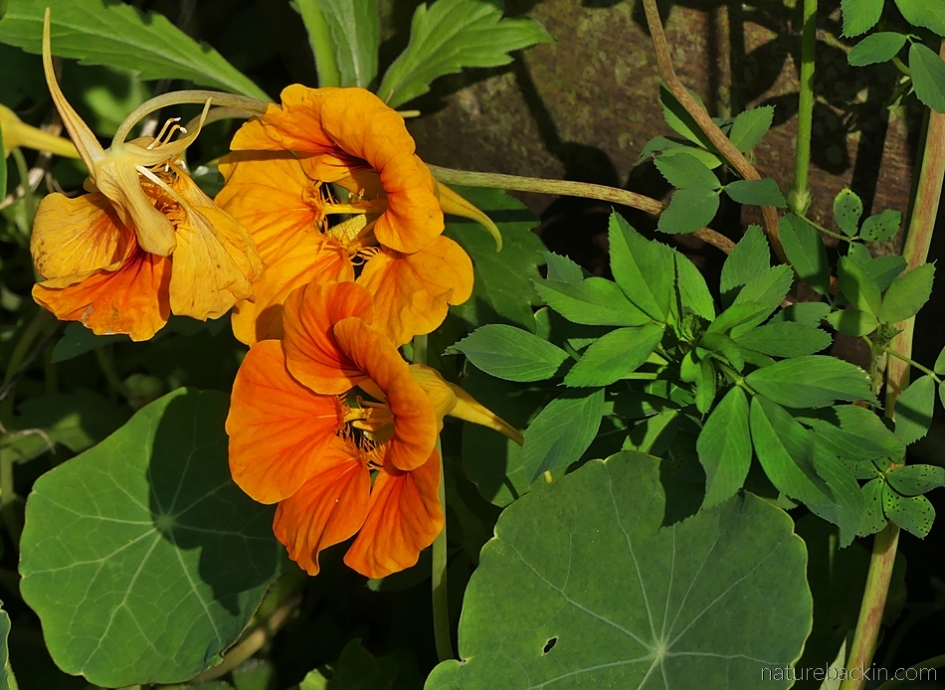
These nasturtiums nestle together with some alfalfa (lucerne) leaves. We grow nasturtiums in the veggie garden largely because of their cheerful and old-fashioned presence, and of course the leaves and flowers are edible. Also nasturtiums serve as a trap plant for aphids. The aphids are attracted to the nasturtiums in preference to cabbage plants, for example. If the nasturtiums become thickly infested with aphids, the plants can simply be removed and disposed of – I put them on the compost heap.
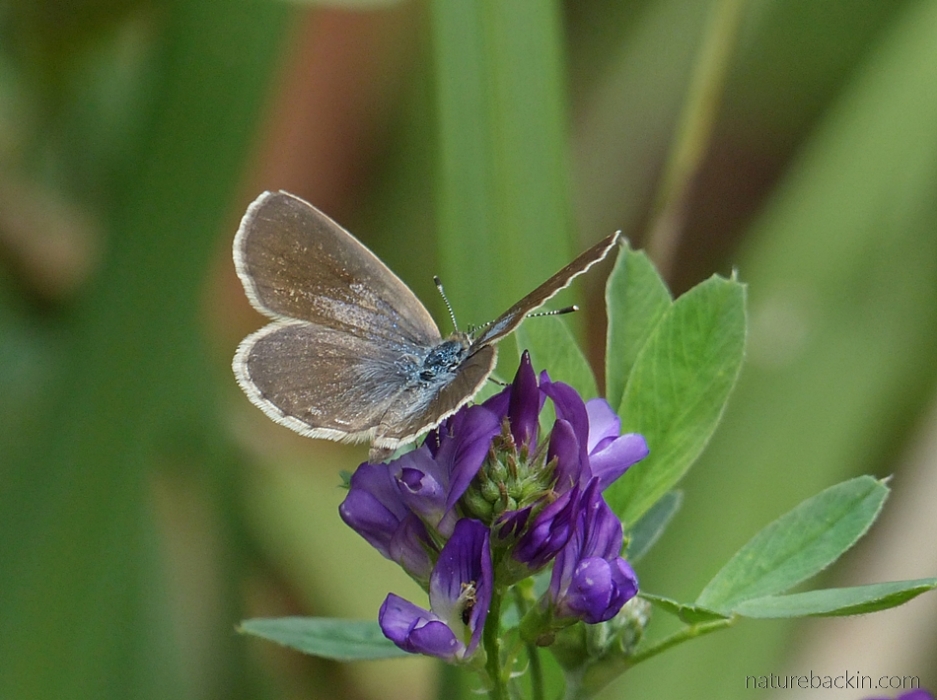
I photographed this butterfly, one of the Blues, visiting an alfalfa flower last summer. Alfalfa is deep rooted and is reputed to be rich in minerals and other nutrients. It makes a good tea (I chop up fresh sprigs to use as a tea), and sprigs can be added to salad or stews. Clippings from alfalfa plants can be used to improve the compost heap, or to use as mulch around vegetables and other plants.
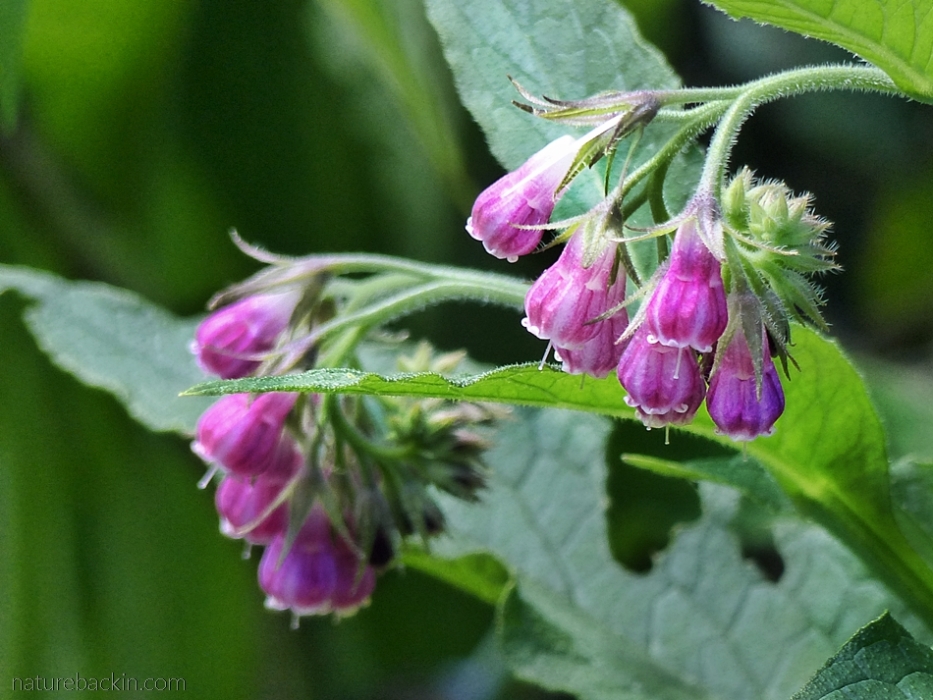
Comfrey is another herb we grow in our herb patch – not to eat but to add its leaves to our compost heap as it is said to a good bio-activator. It is also very decorative when in flower.

This wild rocket is currently flowering. It survived through the winter just enough to produce leaves to add to salads and to have on bread with tomatoes. A friend divided one of her plants over a year ago to give us a rooted slip that has gone on to thrive in our garden.
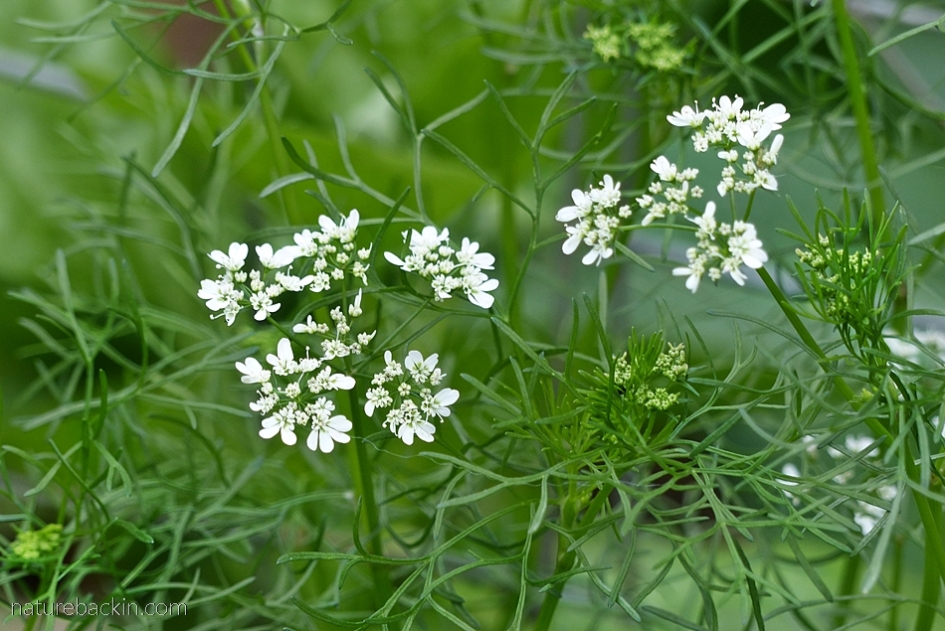
In a previous summer I photographed this coriander (dhania) plant in flower. We find that coriander plants quickly pass their best from the point of view of picking leaves to flavour curries and other dishes. However, leaves picked in their prime can be chopped and frozen in water using ice cube trays so as to keep a stash in the freezer to use in cooking when needed. I discovered some tiny self-seeded plants developing in our herb patch today. Hopefully they will continue to grow and provide us with leaves as we progress into summer.
Although not photographed, we did grow carrots through the winter. They don’t do well in our soil so we grow them in large posts with quite a high percentage of sand added to the soil and they do much better. The peas that we got at the farmers’ market matured to bear pods, but not prolifically so each pod was a small treat of sweet peas to share and eat raw.
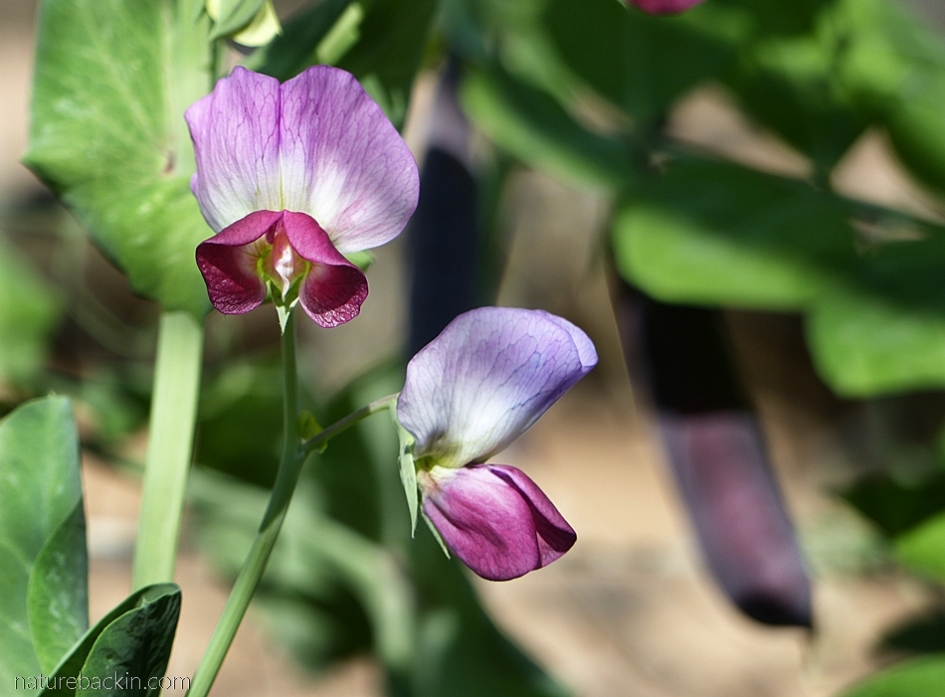
In a previous year we grew some peas that had purple pods. As far as I remember they were marketed as an heirloom variety. The flowers were very attractive, having pink and purplish hues.
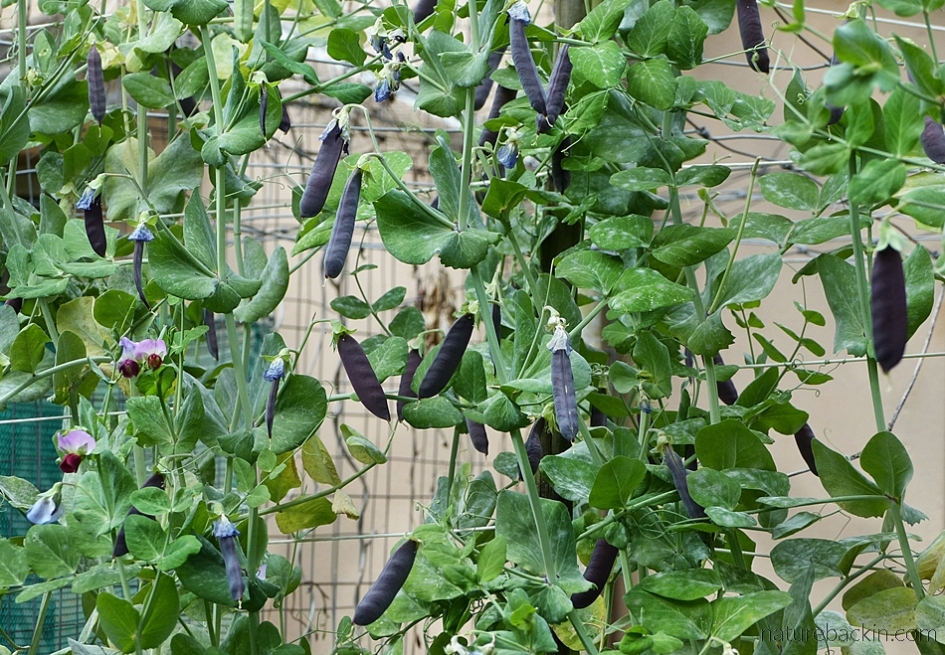
These purple peas were most productive and did very well – but even though they were prolific, they were so nice and sweet that we only ever ate them raw.
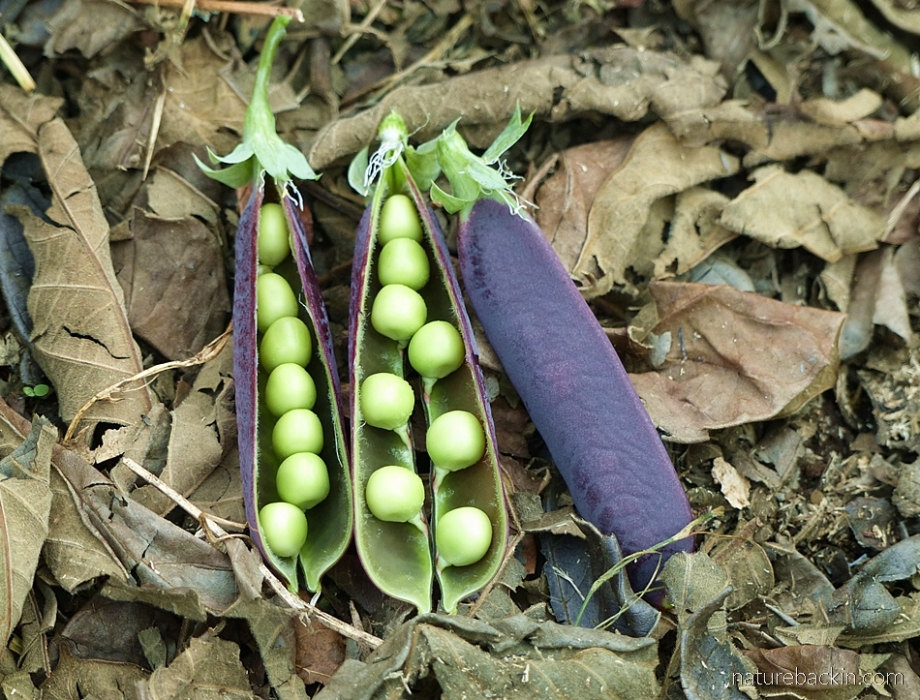
Although the pods were purple, the peas were green! We kept some peas to dry to plant the following year, but sadly none of them germinated. I have not seen these peas available in the seed shops since so I should really look to see if they are sold online.
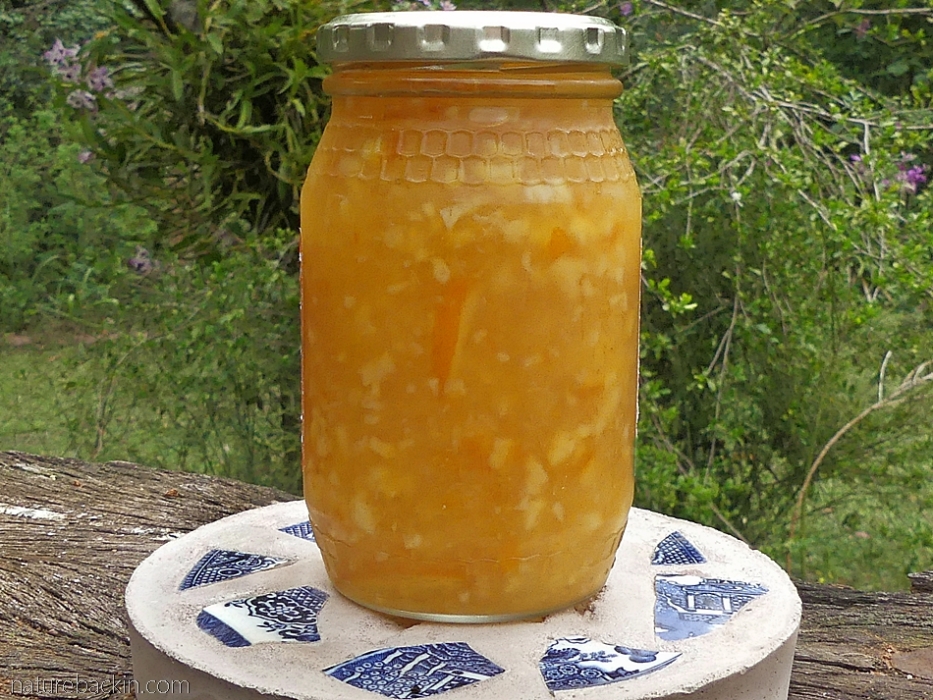
One aging grapefruit tree and two lemon trees grow in our garden. We bought a few oranges and of course sugar to combine with grapefruits and lemons, and I made a few jars of ‘three fruits’ marmalade during the winter. I used a recipe for small batches of marmalade that can be cooked by using the microwave oven rather than boiling the mixture on the stove top. The photo is of the last remaining jar of the two batches that I made.
At the last farmers’ market we took a chance buying broccoli seedlings because broccoli is known to do best where the winters are cold, which is why with our mild winters we have not tried growing it before. Somewhat fortuitously we had an unusually cold winter and the broccoli did unexpectedly well. Having read that for broccoli to flourish it should not be allowed to dry out, I watered the plants every second day, sometimes using the stored rainwater from our water tank.
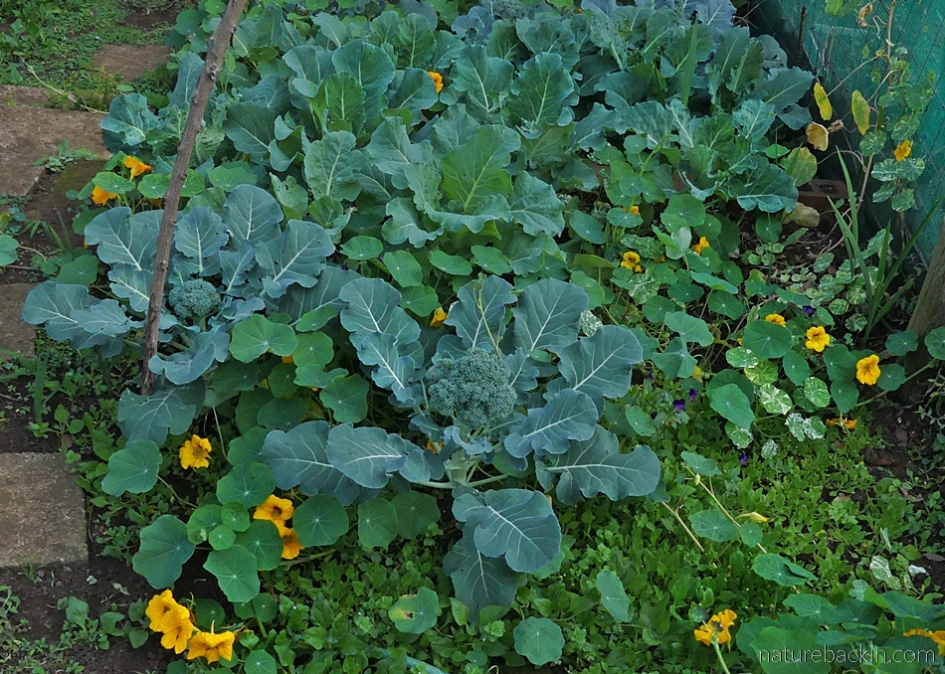
Two of the broccoli plants with heads nearly ready for picking can be seen in the photo. Behind them are some Cape spitz cabbages. The cabbages have not formed the conical heads we expected, but the leaves are still very tasty. A great way of cooking cabbage is to lightly fry chopped garlic in olive oil before adding shredded cabbage leaves. Turn the shredded leaves in the oil adding a few tablespoons of water if necessary so as to kind of braise and stir-fry the cabbage for a few minutes until cooked to taste. Add some black pepper and enjoy.
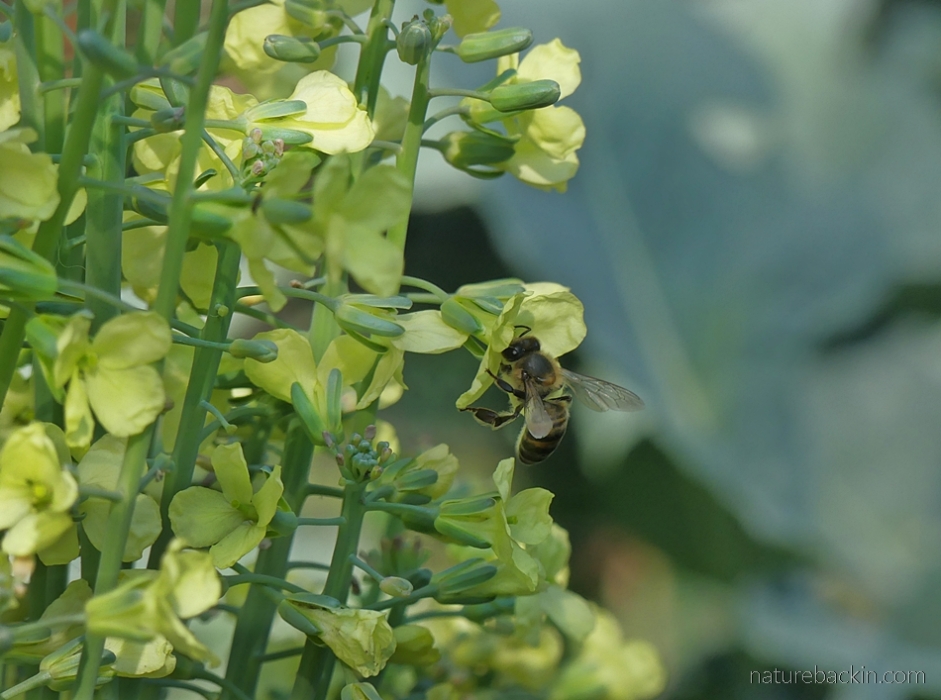
The broccoli plants all became ready for harvesting simultaneously. One head got left behind on the plant and very quickly it flowered. The flowers are rather attractive, and this honeybee thought so too.
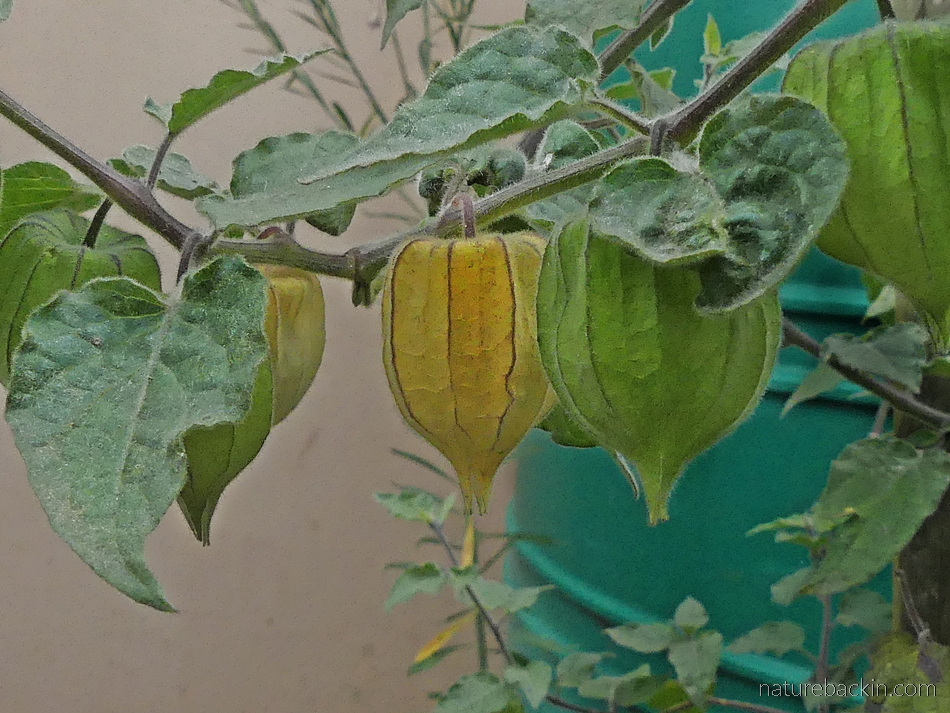
And as a sweet ending, Cape gooseberries most beautifully wrapped in their lantern-like papery casings provide a fruity delicacy to be enjoyed while gardening or at the end of a meal. We never chose to plant Cape gooseberries in the garden but seedlings just appeared, probably due to seed being dispersed by birds. We left this plant to get quite large in a corner of the veggie garden where it screens the green plastic water tank that can be seen in the background.
This week we have had quite good and very welcome rain with more forecast along with colder temperatures, and even light snow falling in parts of the country. We are hoping that the drought-stricken parts of the country will also be blessed with rain that is set to be widespread, falling in both the winter and the summer rainfall regions. If I have an excuse for posting a day late this week, perhaps it is the colder weather?
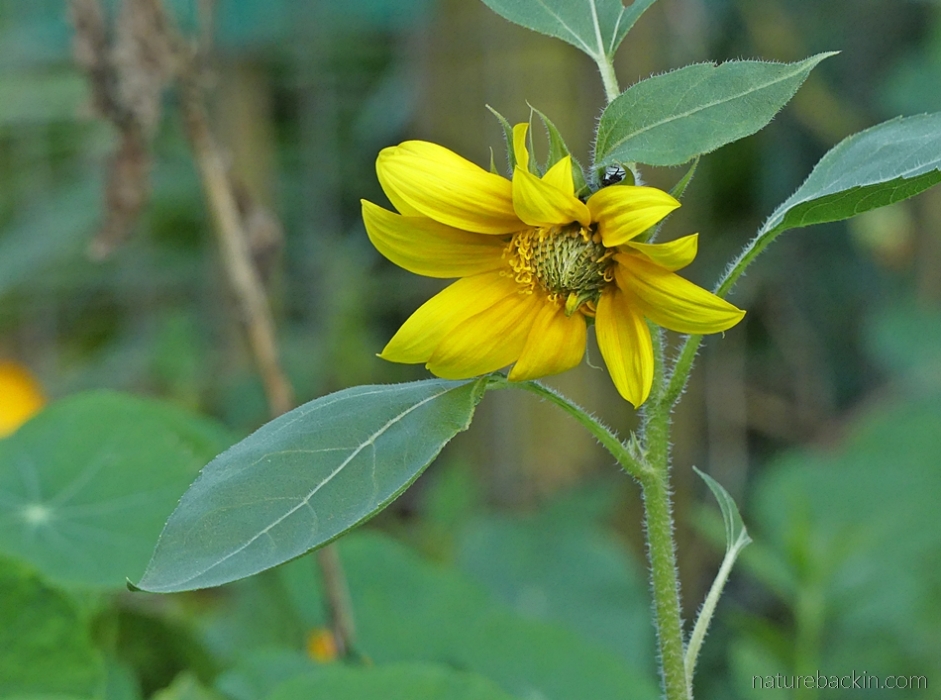
Another self-sown delight currently brightening up the veggie garden is this cheerful sunflower, which provides for visiting insects and birds.
Since the first severe lockdown period of the pandemic that started in late March, over the past six months less severe levels of lockdown have gradually been introduced, and the September easing of regulations saw the local farmers market reopening for the first time since March – in good time for us to source summer vegetable seedlings to bring home to plant in the garden.
Other food-related posts from naturebackin:
Connecting with our bread-making heritage: An easy and quick bread recipe
An unexpected guest: A longhorned beetle in the spinach patch
Letting nature back in via a kitchen garden
Salad in the cupboard: Sprouting lentils
Wheat, war, bread and biscotti
Nature’s bounty in the kitchen
Posted by Carol

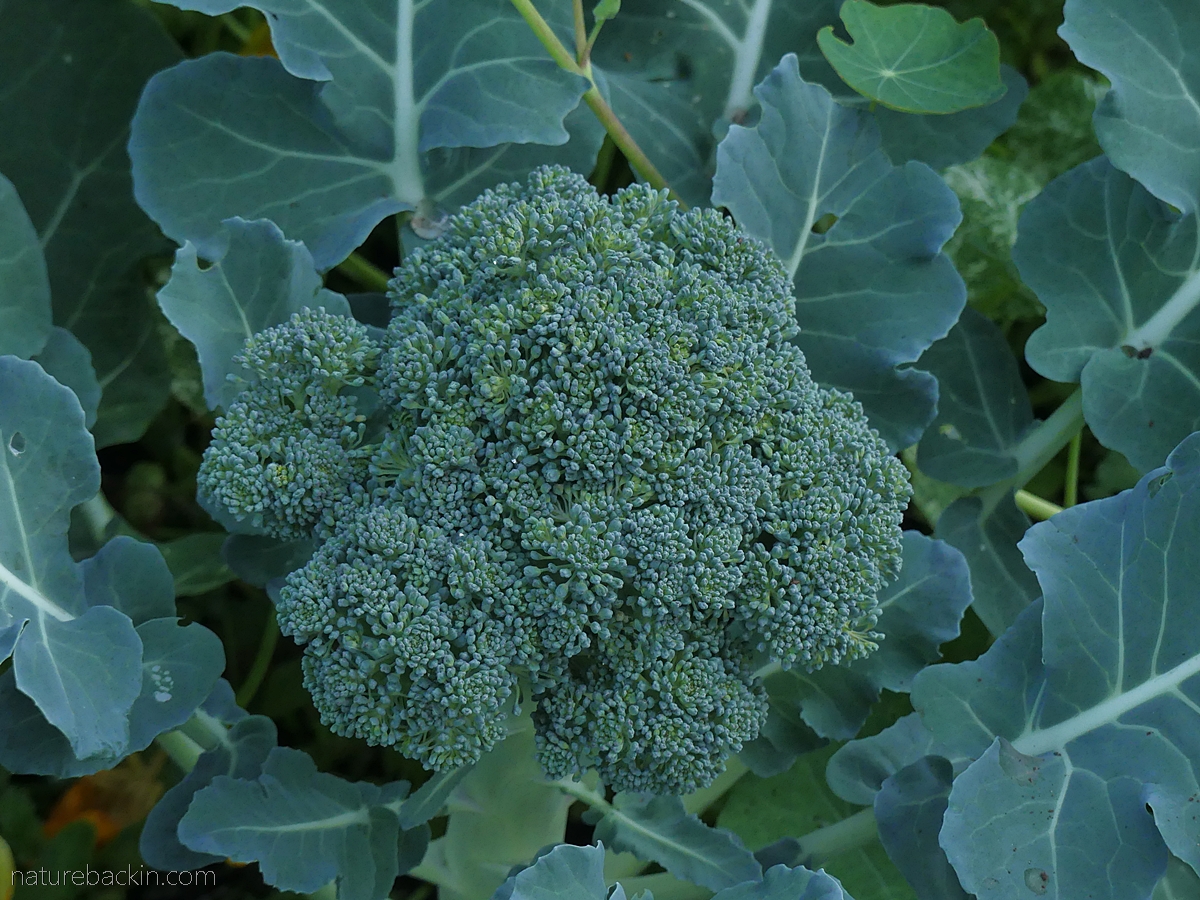







November 15, 2020 at 8:52 pm
Woww!
LikeLiked by 1 person
November 16, 2020 at 8:28 pm
Thank you!
LikeLike
October 20, 2020 at 7:27 pm
That is an impressive veggie patch! The purple peas are most interesting. I have grown a few things from time to time but never as varied as yours. One idea that is slowly gaining traction here is the ‘community farm’, which is basically a giant allotment tended by volunteers or stakeholders.
LikeLiked by 1 person
October 20, 2020 at 8:47 pm
The lockdown made me a more attentive veggie gardener than usual!
Community gardens are a great idea. Good to know they are gaining some traction where you are.
LikeLiked by 1 person
October 6, 2020 at 4:10 am
We too have adapted to growing those vegetables that can survive in our conditions. During winter when water is scarce our garden is dormant. Over 20mm of rain fell over the last few days, so hopefully I’ll be able to plant soon! Love your garden Carol! xxx
LikeLiked by 1 person
October 8, 2020 at 9:24 pm
We are lucky our garden never goes dormant due to the mild winters.
Glad to hear you are getting decent rains. Hopefully there is happy planting ahead!
LikeLiked by 1 person
October 5, 2020 at 10:12 am
What a lovely healthy-looking broccoli! Like you, this has been a good year for broccoli! We have similar conditions here: hot, humid and mainly clay soil, hence the use of raised garden beds for the vegetables. Our go-to tomato variety is also the cherry tomato, and these are just popping up throughout the garden now, no more than about 30 cm high. They self seed everywhere! That is a great tip about the nasturtiums as a harbour for slugs and snails and as a trap for aphids. We harvested as much nasturtium seed as possible yesterday and are going to pickle them as caper substitutes – a first for us! Lovely plated leafy greens, plus some colour. Is it just the leaves of the Spekboom that are edible, and do you eat them fresh? Interesting about the alfalfa; I might try and grow some next winter as it seems to be so worthwhile. The only way we can grow carrots is in large pots, and this system is working well as we successional plant them one pot at a time.
Interesting about the purple podded peas. We came across them recently at a garage sale, and I was given a couple of pods, which I dried and stored for next winter. We grow purple runner beans and they are really tasty. I’m looking forward to tasting the purple podded peas! The flowers are beautiful.
Our Cape Gooseberries succumbed to a plague of small black worms, so we have removed all the plants. I have one remaining plant squirreled into the front garden, hoping that it survives to produce fruit before the worms find it.
Glad your restrictions are easing to allow farmers markets again. Good luck with your summer crops!
LikeLiked by 2 people
October 8, 2020 at 9:21 pm
It is interesting to compare notes. I have thought about pickling nasturtium seeds but not done it yet. Btw, I have only noticed the nasturtiums trapping aphids and not snails and slugs.
Interesting to that you have also resorted to pots for successful carrot growing.
I have seen seeds for purple runner beans on sale so perhaps will give them a try – thanks for the tip.
Re Cape gooseberries, I am sharing the current fruits with the white-eyes!
I need to get planting for summer veg but the weather has veered between considerable extremes making gardening a bit tricky.
LikeLiked by 1 person
October 5, 2020 at 9:30 am
What a feast your veggie garden. 🙂
LikeLiked by 1 person
October 8, 2020 at 9:17 pm
A relatively good yield this winter!
LikeLike
October 3, 2020 at 3:35 pm
I so enjoyed this post and your approach to gardening. I recall many wonderful leaves picked for my work sandwiches from your garden which you kindly shared with us.
LikeLiked by 1 person
October 4, 2020 at 3:13 pm
Thanks Christine. We used to so enjoy sharing the pickings while you were here. Those were good days …
LikeLike
October 3, 2020 at 6:00 am
9mm soft rain along with this inspiring look at your vegetable garden gets my gardening juices flowing! So far I have only manged bush peas (all eaten raw!) and parsley. Hopefully the ground will soften enough to clear and I can start afresh.
LikeLiked by 1 person
October 4, 2020 at 3:08 pm
I am so happy that you have had some lovely rain, and I hope you get some more. WInter peas and parsley were at least something during your drought.
I also hope that you will be able to plant a decent amount of veggies soon, but at least you should be able to start small quite soon with a few lettuce plants or something like that. Fingers crossed for more lovely rain …
LikeLike
October 3, 2020 at 4:01 am
What a grand tour of your garden, which is more productive than any I’ve had. I tried growing broccoli in Washington State and ended up with giant plants that were all leaves and pitifully spindly heads! I Hawaii, things grow easily, but they also get consumed by a wide variety of creatures or succumb to disease, so it’s still hard work to make it succeed. These days I just grow herbs in pots and even that can be challenging. I’m totally with you on eating peas straight from the pod, far better than cooking them.
LikeLiked by 1 person
October 4, 2020 at 3:05 pm
That our first-time broccoli worked out was a big surprise. We were lucky with a colder than usual winter, which probably helped.
Disappointing that you can’t successfully grow much veg in Hawaii. At least you have got some potted fresh herbs. Have you ever tried growing micro greens indoors? It is on my to do list to try that one of these days.
We will have to wait several months to plant peas again as our summers are way too hot for them, and yes it is a waste to cook them.
LikeLiked by 1 person
October 4, 2020 at 4:20 pm
I have thought about indoor greens and may yet give that a go. I could do a garden outside, but it would need raised beds and fencing and probably even covering of some kind. It would be a lot of work and since it’s not clear how long we’ll be in this house, I haven’t wanted to put all that time in and then end up moving.
LikeLiked by 1 person
October 8, 2020 at 9:14 pm
I know what you mean about such an investment, especially when moving is a possibility. I thought about trying to grow tomatoes in more sheltered circumstances but it would have involved quite a bit of work and expense for a potential yield of no more than about a dozen tomatoes, which can easily be got at the farmers market!
LikeLiked by 1 person
October 9, 2020 at 4:18 am
That’s the other thing. We have a good local market here too.
LikeLiked by 1 person
October 3, 2020 at 1:52 am
Our two cherry tomato plants did exceptionally well this year. Perhaps it was the unusual days of heat we had. I love the way you mix it up with veggies and flowers. The purple peas are a delight. Sweet peas never get a chance to get cooked around here either. To me, they’re like candy.
Thanks for this delightful and informative post. I’ll have to try one or two of your suggestions. 🙂
LikeLiked by 1 person
October 4, 2020 at 2:59 pm
Those cherry tomatoes are such a useful bonus in the garden. I agree that freshly picked peas are a treat like candy.
I guess any veggie gardening for you will have to wait until your spring, or is there anything that will survive your winters, even if its just a pot of herbs on a windowsill?
LikeLiked by 1 person
October 4, 2020 at 10:49 pm
Our weather normally is rather mild (both winter and summer), but it’s the near vertical slope we live on that makes gardening a distinct challenge. I seem to do better with houseplants rather than actual veggie gardens. But then we’re so lucky to be close to that farm I posted a while back. Getting unfamiliar veggies has broadened my cooking skills without a doubt. That’s a bonus!
LikeLiked by 1 person
October 8, 2020 at 9:16 pm
Yes you are lucky to have access to all that lovely and varied produce. Veggie gardening can definitely be over-romanticized!
LikeLiked by 1 person
October 2, 2020 at 7:36 pm
Hi Aunty Carol
There is a company that you can order your purple peas from. Called Living seeds. They have a huge variety of heirloom seeds. I have used them before.
Thanks for this post. It’s inspiring as I wait for my built up veggie beds to be completed, I too will be gardening like crazy after this cold snap. Thankfully I started my seeds mid August and kept them in my sunny kitchen. They are longing to be planted out 😉.
Happy gardening. ❤️🌿🌱🍓🍒🍌🍎🍋🥬🥒🌶🥑🥦
LikeLiked by 1 person
October 4, 2020 at 2:57 pm
Thanks very much for the info Debs.
Built up beds sound great and a good idea to start the seeds early and keep them indoors. At least the cold snap is accompanied by rain – here at least, I hope you are getting rain too?
Happy spring gardening to you too!
LikeLike
October 2, 2020 at 6:14 pm
As you would expect, I loved this tour of your veggie garden, Carol. It is always interesting to see how different growing in other climates is, challenges and all. I like that your climate allows year-round gardening, as our simply does not!
LikeLiked by 1 person
October 4, 2020 at 2:54 pm
Thanks Eliza. I realize I have been taking for granted being able to grow winter vegetables! Our circumstances certainly are very different – it is so interesting to compare though as you say.
LikeLiked by 1 person
October 2, 2020 at 3:23 pm
Love, love, love this post.
LikeLiked by 1 person
October 2, 2020 at 10:37 pm
Thanks Nikki. I am nowhere near as adventurous as you are when it comes to food and foraging, however I am amazed how many edible and productive plants can be grown in quite a small space in all seasons. Such a pleasure to have such freshness at one’s fingertips. I hope you are enjoying the first real rains of springtime despite the cold!
LikeLike
October 2, 2020 at 2:51 pm
Gardening is a great source of satisfaction. We had quite a large garden when younger, but now use mainly containers to grow lettuce, cherry tomatoes, cucumbers, radish, peppers and eggplant. It’s amazing how much we harvested without a lot of back breaking labor.
LikeLiked by 1 person
October 2, 2020 at 10:32 pm
Growing edible plants for the table can be particularly satisfying. Your containers for growing veg sound great and most productive, and even better that the labour required is relatively minimal.
LikeLiked by 1 person
October 2, 2020 at 2:31 pm
A cornucopia of garden delights. Thank you for the ‘walk’ through your veggie patch and for the useful information. Now I know why my latest small crop if cabbage did not get covered in aphids — a trail of nasturtiums have self-seeded beside them. Am enchanted by your plate of lockdown leaves. Had never thought to put spekboom in salad.
We have almost matching veg and herb gardens! I too cannot grow sage. Coriander is also one of my favourites and I will now freeze some of the delicious leaves. This year I bought and sowed fresh seeds as it had disappeared from the garden, as has the self-seeding borage (for courage). The toll of the drought.
For the second day in a row it is drizzling. Thanks be.
LikeLiked by 1 person
October 2, 2020 at 7:08 pm
How interesting about the nasturtiums’ intervention! I only nibble on spekboom leaves as a kind of snack – they are quite thirst quenching.
I also need to top up on new coriander plants from time to time. (I have just seen that the photo was missing from the post! Strange. I think I have fixed it.)
I really like borage but when I grow it here it goes kind of floppy and collapses. Perhaps I should try it again in pots.
Great news that you are in a second day of drizzle. I hope it really soaks into the parched soil and there is more to follow.
LikeLike
October 3, 2020 at 8:45 am
The Nasturtium Intervention could be the title of a poem or short story about gardening. Borage seems to like hot, dry conditions do perhaps Natal is too humid for it to flourish.
It rained all night. That good, soaking, solid type of rain. Yay!! The small tank is now full and overflowing into the underground tank. 😊
LikeLiked by 1 person
October 4, 2020 at 3:12 pm
It would make a good title! 🙂
I think you right about the borage – although I have seen it doing well in a nearby garden it was in a very sunny and almost arid-looking bed.
So wonderful that you are having soaking rains – and it must be such a relief and comfort for it to be filling your water tanks. I don’t think it is greedy to wish for more gentle rains?
LikeLike
October 4, 2020 at 3:16 pm
More rain would be a real bonus
LikeLiked by 1 person
October 4, 2020 at 3:17 pm
It would indeed. We have had more light rains today – and the cold persists too! I hope you keep warm and cosy.
LikeLiked by 1 person
October 2, 2020 at 1:42 pm
A refreshingly different post from you – and you seem to be a rather successful veg gardener. Your picture of broccoli reminded me of one dreadful year when I steamed some purple sprouting broccoli from our allotment, which I’d washed none too carefully because it was from our allotment after all), and discovered I was sitting us down in front of a dish of … dozens of carefully steamed caterpillars…. Lunch rapidly lost its appeal.
LikeLiked by 2 people
October 2, 2020 at 6:41 pm
How funny! And I bet we’ve all done it… knowingly or otherwise! Insects and other small creepies have been well documented as a viable source of protein so you are right on trend there
LikeLiked by 2 people
October 3, 2020 at 6:35 am
We decided not to get our protein fix that way though 😉
LikeLiked by 2 people
October 4, 2020 at 2:52 pm
🙂
LikeLike
October 2, 2020 at 7:00 pm
Eeuw – the risks of organic gardening!
LikeLiked by 1 person
October 3, 2020 at 6:35 am
And easily avoided if I used my eyes.
LikeLiked by 1 person
October 2, 2020 at 11:01 am
An inspiration for everyone
LikeLiked by 2 people
October 2, 2020 at 6:58 pm
Thanks very much Athira.
LikeLiked by 1 person
October 2, 2020 at 8:30 pm
Most welcome !!
LikeLiked by 1 person